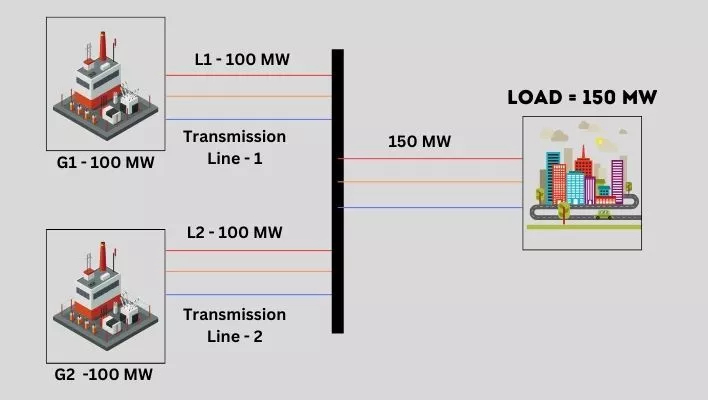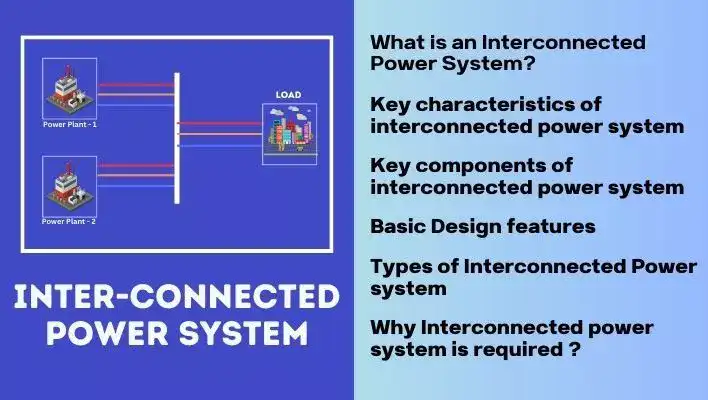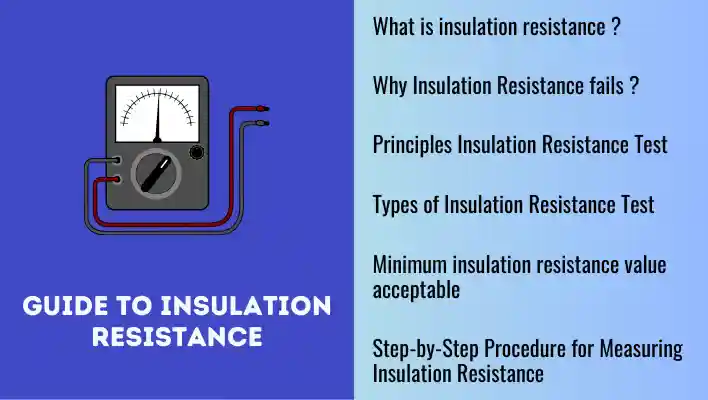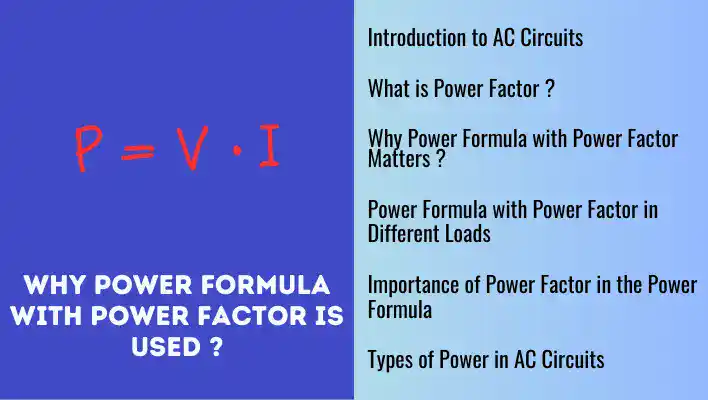In our modern world, interconnected power systems are like the unsung heroes of the electricity supply. They’re the behind-the-scenes champions that keep our lights on. This blog post is your guide to these systems, breaking down the reasons and advantages which makes them the most important and greatest engineering achievements
What is an Interconnected Power System?

Also Read: Power Supply System | A Comprehensive Guide
In earlier days, power-generating stations were situated near load centers, such as industrial, commercial, or residential areas. Hence, there was no need to connect several generating stations together.
However, in modern times, the demand for electricity has steadily increased. Therefore, to meet the rising load demands, several power-generating stations now connect to create today’s interconnected power system or National Grid.
In simpler terms, we can define it as the interconnection of two or more generating stations to form a single grid that caters to the power needs of multiple zones across a large territory according to demand.
In engineering terminology, it can be described as the parallel connection of multiple power generation stations. Essentially, it involves interconnecting the buses of more than one generating station to utilize the unused power capacity of connected generators during peak demand.
It can also be described as a distribution system with multiple power sources that can loop throughout the network. If one source fails, another source can be activated to maintain service.

For example, refer to the above figure showing two generating stations G1 and G2 having a generating capacity of 100 MW each.
The G1 and G2 are supplying I1 and I2 to the load through transmission line 1 and 2.
Both transmission lines 1 and 2 deliver equal power, and the system operates at the same terminal voltage.
These both generating stations are connected parallel and are supplying power to a territory having a load of 150MW.
Now it is impossible for one generating station to fulfill the load requirement of 150MW. So in such cases G1 will provide the 100 MW of load and G2 will provide 50MW. This is how interconnected systems help in filling the deficit of required load of 150MW.
key characteristics of interconnected power system

Also Read: Understanding Conventional Power Plants – A Detailed Exploration
The key characteristics and components of an interconnected power system, also known as an interconnected electrical grid or an interconnected power grid, include:
- Reliability: Interconnected power systems make sure that our electricity supply remains reliable. If blackouts occur due to tripping caused by faults, equipment failures or natural disasters, these systems help by bringing electricity from other places. This way large-scale power outages that impact many people are prevented.
- Resource Sharing: Interconnected grids make it easy to share energy efficiently. We can generate electricity where it’s cheapest and send it to places where demand is high. This way, we use our resources better.
- Load Balancing: Multiple interconnections enable grid operators to balance electricity supply with demand more effectively, preventing overloads during peak periods and ensuring a stable power supply
- Integration of Diverse Energy Sources: Interconnected grids allow for the integration of various energy sources, including renewable energy like wind and solar. This integration smooths out variations in generation, ensuring a consistent power supply.
- Energy Security: Cross-border interconnections enhance energy security. Neighboring regions or countries can support each other during supply shortages or emergencies, reducing vulnerability to disruptions
- Economic Benefits: Interconnected grids facilitate economic growth by providing a stable and cost-effective electricity supply. They also promote competition in energy markets, potentially lowering prices for consumers.
- Environmental Considerations: Interconnected power systems help protect our environment. They facilitate the integration of cleaner energy sources thereby promoting energy efficiency and reducing greenhouse gas emissions.
- Efficient Long-Distance Transmission: These grids enable the efficient transmission of electricity over long distances, reducing energy losses during transportation.
- Flexibility and Adaptability: Interconnected grids are flexible and adaptable to changing energy demands and emerging technologies, accommodating shifts in power generation and consumption patterns.
- Grid Resilience: Sharing resources and quick recovery from outages enhance grid resilience. Interconnected systems are better equipped to handle natural disasters, equipment failures and other disruptions.
key components of interconnected power system

- Power Generation Sources: These include various types of power generation sources such as conventional power plants (e.g., coal, natural gas, nuclear, hydroelectric), renewables (e.g., wind, solar) and distributed energy resources.
- Transmission Network: High-voltage transmission lines and substations form the core of an interconnected power system, facilitating the long-distance transfer of electricity.
- Distribution Networks: Lower-voltage distribution lines and substations deliver electricity to homes, businesses, and industries.
- Interconnections: These points or interfaces enable the flow of electricity between different regions or areas within the grid, enhancing reliability and resource sharing.
- Grid Management and Control Centers: Grid operators and control centers monitor and control the grid in real-time, ensuring supply meets demand, maintaining grid stability, and responding to unpredictable power demands.
- Relay Protection Systems: These systems detect and isolate faults or abnormalities to prevent widespread outages.
- Energy Markets: Many interconnected power systems include energy markets for buying and selling electricity among utilities, generators and consumers, promoting competition and efficient pricing.
- Cross-Border Interconnections: In international interconnected grids, cross-border interconnections allow neighboring countries to exchange electricity, enhancing energy security and cooperation.
- Energy Storage Systems: Energy storage solutions, such as batteries, can be integrated to store excess energy and release it when needed, helping balance supply and demand.
- Control and Monitoring Systems: Advanced technologies and communication networks enable grid operators to monitor grid performance, control equipment remotely, and make real-time decisions for stability and reliability.
These characteristics and components collectively contribute to the efficiency, reliability, and resilience of an interconnected power system, enabling it to provide a stable electricity supply to diverse consumers over a wide geographic area while accommodating changes in energy generation and consumption.
Basic Design features of an Interconnected power system
The basic design features of an interconnection is based on the following elements:
- AC or DC Nature: Deciding whether to use AC (alternating current) or DC (direct current) for an interconnection depends on a few important things:
Distance: How far the electricity needs to travel is a big factor. AC is usually better for shorter to medium distances. It works well for delivering power in cities and regions.
Efficiency: AC is efficient when you’re moving power over shorter distances. This is because AC can easily change its voltage levels using transformers. That makes it good for different types of power distribution, from high voltage in big power lines to lower voltages in homes and businesses.
Long-Distance Transmission: On the flip side, DC is a better choice for really long-distance connections. When electricity travels over long lines, DC loses less power compared to AC. This happens because DC lines have less resistance and reduced losses associated with capacitive and inductive reactance, which tend to be more of a problem for AC lines when used over long distances.
- DC Configuration: The configuration depends on the project’s requirements and design considerations.When using DC for power connections, there are two setups: single-pole or double-pole (+/-).
Single-Pole DC Setup: This uses just one conductor, usually the positive one, to send power. To complete the circuit, the electricity returns through the earth or another conductor.
Double-Pole DC Setup: Here, both positive and negative conductors are used to transmit power. The current flows out from the positive pole and returns through the negative pole, making a complete loop for efficient power transmission.
- Transmission Capacity: It is the amount of power an interconnection can handle without getting overloaded. It’s measured in MVA (mega-volt-amps). The capacity is determined by the size and rating of the transmission lines and equipment, considering factors such as safety margins and future load growth.
- Transmission Voltage: The transmission voltage, usually measured in kV (kilovolts), indicates the voltage level at which power is transmitted through the interconnection. Higher transmission voltages are preferred for long-distance interconnections, as they reduce energy losses during transmission. Typical transmission voltage levels range from 100 kV to 1,000 kV or more, depending on the design and requirements.
- System Components and Overall Design: An interconnection consists of various components, including transmission lines, substations, converters (in the case of DC interconnections), transformers, circuit breakers, and protective relays. The overall design considers the location and arrangement of these components to ensure efficient power flow and system stability. For example, substations may be strategically placed at key points along the interconnection to facilitate voltage transformation and control.
- Operating Agreement: An operating agreement is a critical aspect of interconnection design. It outlines the terms and conditions for the exchange of power between interconnected systems or utilities. This agreement includes technical specifications, operating procedures, maintenance protocols, and dispute resolution mechanisms. It ensures that both parties adhere to mutually agreed-upon rules for safe and reliable operation.
Types of Interconnected Power system
Numerous technical websites have mentioned, without proper verification, that the following are categories of interconnected systems:
- AC type
- DC type.
- AC-DC Hybrid type.
In reality there are no types of Interconnected Power System
I’m uncertain about the origin of this misinformation, but these terms more accurately describe types of transmission systems rather than categories of interconnected power systems. In my perspective, all AC or DC transmission systems fall within the umbrella of interconnected power systems.
The term “interconnected power system” can have different interpretations and may be used differently in various contexts. But in electrical engineering and power systems, interconnected power systems typically refer to grids or networks that are physically connected to allow for the exchange of electricity.
While AC and DC systems are different modes of power transmission, they may not always be categorized as “types” of interconnected power systems in the strictest sense. Instead, they represent different methods or technologies used within interconnected power systems to transmit electricity over various distances and for specific applications.
Also Read: Importance of Power Transmission Lines | Explained
advantages of interconnected power systems
The advantages of interconnected power systems can be explained as follows:
- Sharing Peak Loads: Interconnected systems let regions share extra power during times of high demand, making electricity supply more stable.
- Boosted Reliability: When many power plants are connected, the system becomes more reliable because there are backups if something goes wrong.
- Reviving Older Plants: Older power plants that can’t handle peak demand on their own can work well when connected to newer ones, making better use of existing resources.
- Efficiency: Power plants work best when they run at a high load factor. Interconnected systems help make sure they run at full capacity more often, which saves energy.
- Balancing Thermal and Hydro Power: Interconnected systems allow for a smart mix of power sources. In summer, when there is less water in dams, more thermal power can be used. On the other hand, in rainy seasons, hydro power can be optimized to provide more power than thermal power.
- Smart Resource Use: These systems use different energy sources and plants efficiently. This means energy reserves can be planned well to ensure steady power generation.
- Cost Savings: By sharing resources and coordinating, interconnected systems reduce both upfront and running costs, which saves money.
disadvantages of interconnected power systems
- Inadequate Power Supply: When there isn’t enough extra power available, having interconnected systems may not be practical. This is especially true in countries where electricity demand is growing faster than the ability to generate it.
- Planning Challenges: Each area within an interconnected system must carefully plan how much power it can generate and maintain sufficient backup capacity. This requires precise forecasting and coordination, which can be complex and costly.
- Voltage Problems: Keeping the voltage stable is super important in interconnected systems because if one area has a voltage issue, it can spread to other places and cause big problems.
- Imbalances: In interconnected systems, if one area starts using more electricity because they don’t have enough, it can throw the whole system off balance. This can lead to overloads, instability and other operational problems which in turn affect the reliability of the entire network.
- Expensive Control Centers: Managing big interconnected systems requires spending a lot of money on control centers and automatic systems to control the flow of electricity. This can be a big expense.
- Instrumentation and Meters: To keep everything running smoothly, you need to have the right meters and instruments in different places. Making sure they’re in place and working correctly adds to the overall cost and complexity.
Why Interconnected power system is required ?
Power systems are interconnected for any of the following significant purposes.
1. Normally, a power system adds more installed generation capacity to handle higher peak electricity demand and to be ready for unexpected power outages.
But instead of adding more installed generation capacity, the power system can make a deal with a nearby power system that has extra electricity. In this deal, the nearby system gives power when there’s a lot of demand, as agreed in the plan.
2. The connected power systems might not have their busiest times at the same hours. This happens because in different regions people have variations in work schedules, sleep patterns and other factors.
For example, one system could reach its peak two hours later than the other. In such situations, they can use their time zone differences to share electricity more efficiently.
3. A power system with lots of hydro power can link up with another system that mostly uses thermal power. This connection helps them share energy.
The idea is to use hydro power when it rains a lot and send that electricity to places that mainly rely on thermal power.
When there’s less water for hydro power, they can use more thermal power. The purpose of such interconnection is better utilization of energy resources.
4. Power systems are connected to each other primarily to provide mutual support in emergency situations.
This means that when one power system faces a sudden shortage or emergency, it can quickly receive a significant amount of electricity from the interconnected system.
In essence, these interconnections act as a safety net for power systems, helping them respond swiftly and effectively to unexpected crises.
FAQs
What measures are taken to enhance the reliability of interconnected power systems?
Reliability measures include investing in robust infrastructure, implementing advanced grid monitoring and control technologies, developing emergency response plans, and fostering collaboration among utilities and regulatory authorities.
What is the difference between isolated and interconnected power system?
Isolated Electrical Power System: Operates independently, serving a local area with limited resources and less reliability due to isolation.
Interconnected Power System: Part of a larger grid network, allows resource sharing, improves reliability, and provides stability through connections with other regions or countries.
What is the impact of renewable energy integration in interconnected power systems?
The integration of renewable energy sources, such as wind and solar, poses both opportunities and challenges. While it contributes to a cleaner energy mix, the variable nature of renewables requires effective grid management and flexibility to maintain system stability.
What challenges are associated with interconnected power systems?
Challenges include maintaining grid stability, managing power flow, addressing transmission constraints, and coordinating operation among different entities. Additionally, issues related to regulatory frameworks and cross-border coordination may arise in international interconnected systems.
How are power systems interconnected across regions or countries?
Interconnections can be established through high-voltage transmission lines that connect the power systems of different regions or countries. These interconnections enable the transfer of electricity between areas, promoting resource sharing and enhancing grid stability.
Are there international interconnected power systems?
Yes, many countries have interconnected their power grids with neighboring countries to enhance regional energy security and cooperation. Examples include the European Union’s grid and the interconnected grids in North America.
Summary
In summary, interconnected power systems offer advantages such as improved reliability, resource sharing, load balancing, integration of diverse energy sources, energy security, economic benefits, and environmental considerations.
However, they can present challenges such as inadequate power supply, planning complexities, voltage stability issues, imbalances, costly control centers, and instrumentation requirements.






